Our understanding of our distant ancestors and their clans was formed in the nineteenth and twentieth centuries, and back then, there were no significant breakthroughs or discoveries. Skulls, jaws, and, more commonly, phalanges and teeth filled museums, prompting only subdued excitement in the specialized academic press. However, in the 2000s, everything changed with the emergence of a new science—paleogenetics. This discipline gave a voice to long-muted remains, unveiled previously undiscovered human species, and provided unparalleled insight into the lives of our ancestors, whose legacy had been preserved solely through bone fragments. Professor Alexander Markov recounts the incredible discoveries made in the last decade.
The first two lectures in this series focused on the Neanderthals and Denisovans, the ancient inhabitants of Eurasia and distant relatives of Homo sapiens. Now, we will journey to humanity's birthplace, Africa, where events of even greater significance unfolded: the emergence of our species, Homo sapiens, or rational humans.
The Creative Class
As early as 300,000 years ago, our African ancestors bore a great physical resemblance to us and displayed signs of symbolic thinking. They contemplated the eternal and the beautiful, sharing their musings with neighbors and ‘friends’. Their brains, like those of the Neanderthals, increased in size, but their development took a different trajectory. While early Homo sapiens retained the elongated shape characteristic of common ancestors, the brains of later Homo sapiens become rounded due to the growth of the parietal lobes and cerebellum, whereas in Neanderthals, the occipital region grew elongated. However, we must still ponder the meaning of these changes with our rounded, or, as scientists say, globular (resembling a globe), brains.
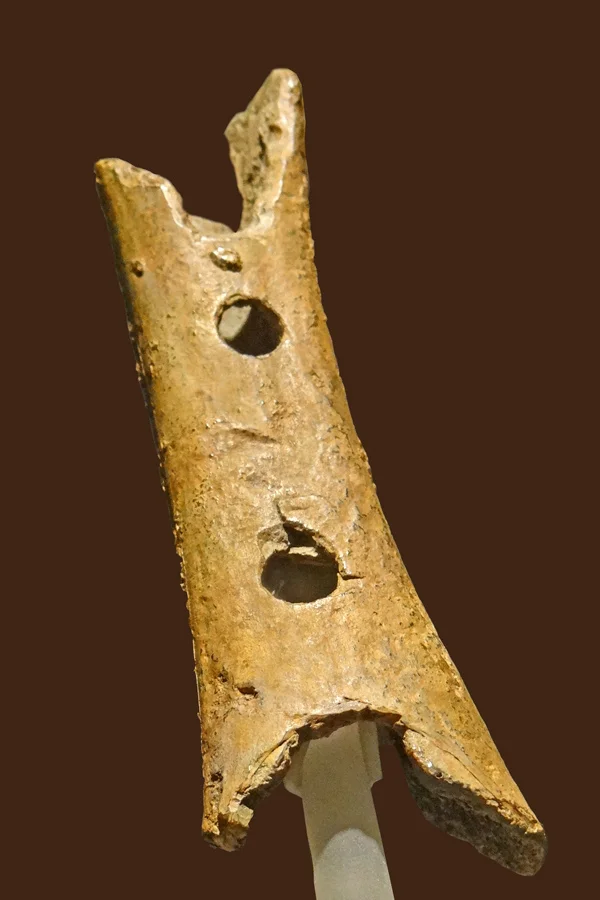
Divje Babe flute/Wikimedia commons
The Neanderthals were hardy and cold-resistant hunters, while Homo sapiens seemed quicker to develop social skills and artistic sensibilities. As far as we know, not 300,000 nor 100,000 years ago did the Neanderthals contemplate music or colors—their world was harsh and monotonous.
The famous Neanderthal ‘flute’ from Divje Babe—a flute made from a cave bear femur with holes drilled into it—was discovered in 1995 at the Divje Babe archeological site in Slovenia. This artifact was created approximately 43,000 years ago, appeared later, and carried the first signs of pigment use. African Homo sapiens were already using ochre and exchanging valuable items as early as 300,000 years ago, and 100,000 years ago, they were employing specialized tools to produce multi-component paints. In essence, their world was inherently more glamorous and complex than the rudimentary lifestyle of Neanderthals.
What Did the First Homo Sapiens Look Like?
The discovery of Jebel Irhoud in Morocco was an accident that happened while archeological work was being conducted in the mountains. In 1961, a well-preserved skull, Irhoud 1, was found in that area, blending modern (sapiens) features with some archaic traits. Irhoud 1's face closely resembled ours and could even be considered attractive, though somewhat rugged. Subsequent excavations uncovered an incomplete skull, Irhoud 2, along with a pair of lower jaws, skeletal fragments, and stone tools typical of the African Middle Stone Age.
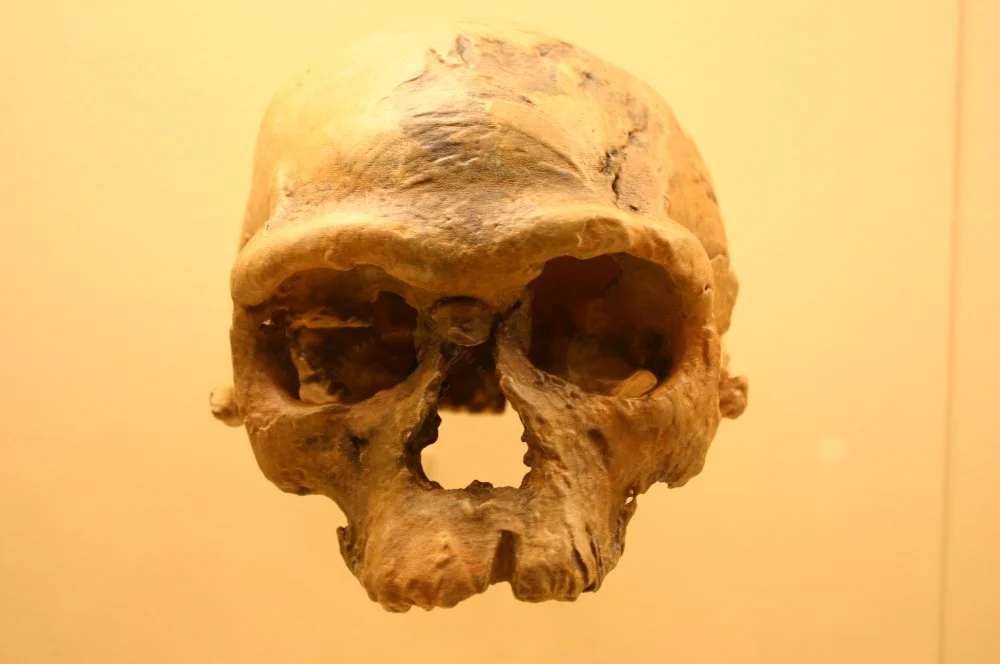
Jebel Irhoud-1/Wikimedia commons
Determining the age of these finds posed a challenge for some time. Estimates varied from 40,000 to 160,000–170,000 years. However, the people from Jebel Irhoud were much older, as was convincingly demonstrated by an international team of anthropologists whose findings were published in the journal Nature in 2017. Additional bone material was discovered during new excavations; in an undisturbed archeological layer, they found another fragmented skull, almost an entire lower jaw, an upper jaw, several skeletal bones, and numerous teeth. In the same layer, burnt flint tools were found, suggesting that the people from Jebel Irhoud unquestionably had mastery over fire. These tools were successfully dated using the thermoluminescence method,i


Some of the Middle Stone Age stone tools from Jebel Irhoud (Morocco). Dated to 300 thousand years ago/Wikimedia commons
Thus, the people from Jebel Irhoud turned out to be much older than previously thought—by approximately 150,000 years. This gives an entirely different meaning to both their modern and archaic features. Before us are the oldest reliably dated representatives of Homo sapiens; if you ever find yourself in Morocco, think about this. Perhaps everything began right here...
Regarding facial structure, the people from Irhoud closely resemble modern humans and differ significantly from the Neanderthals and Homo heidelbergensis, whose faces were much larger and less refined. As for the shape of the brain, it is quite archaic in the Irhoud individuals and more closely resembles those of the Homo heidelbergensis and Homo erectus. Their brains exhibit elongation in the front-back direction and lack the distinct rounded (globular) shape typical of Homo sapiens. It seems that throughout evolution, our ancestors initially developed modern facial features before developing contemporary brain shapes. Beauty preceded intelligence, suggesting a somewhat deliberate and calculated sequence in the evolutionary process.
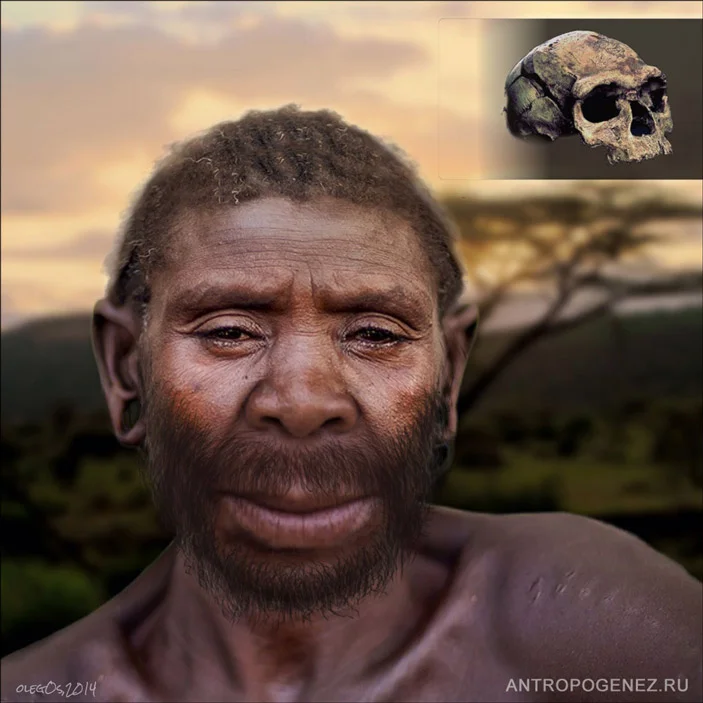
Homo helmei (Jebel Irhud 1)/ Reconstruction was carried out by Oleg Osipov specifically for the portal antropogenez.ru
Overall, the new data suggests that the people from Irhoud could potentially be considered the ancestors of the Omo and Herto peoples from Ethiopia, who were recently regarded as the oldest sapiens.i

‘In the series of forms imperceptibly blending into one another, from any ape-like creature to modern man, it would be impossible to specify which of these forms should first be given the designation “human”. But this is a question of very little importance.’
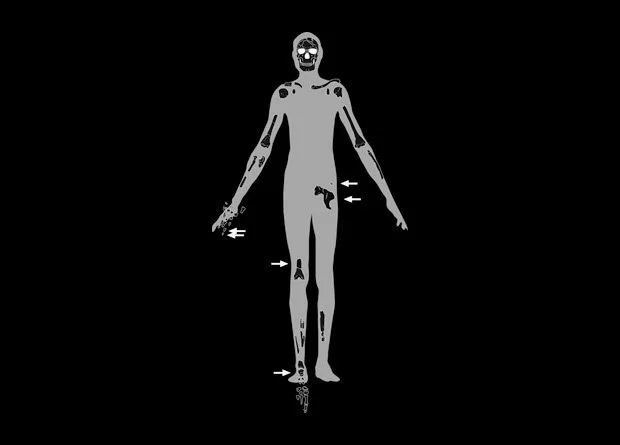
A description of the Omo I postcranial skeleton, including newly discovered fossils. O. Pearson, Danielle F. Royer, F. Grine, J. Fleagle less Published in Journal of Human Evolution 1 September 2008
Nevertheless, even now, anthropologists disagree about the notion of the ‘limited importance of this question’ as evidenced by the ongoing, spirited debates about how to classify the bones of one species from another. When the paleontological record contains numerous gaps, it becomes easier to establish clear boundaries between species that succeed each other over time. The fewer the gaps, the smoother the transitions, and the more complex and rewarding the work of the taxonomist.i
The significance of dating the people from Irhoud lies, of course, not in the fact that, as journalists hastened to report, ‘modern humans are now considered 100,000 years older’. It lies in the fact that we now have a better understanding of the course of the evolution of our lineage after it separated from the ancestors of the Neanderthals. For example, we have grounds to believe that our facial features acquired their current structure earlier than the brain. Moreover, it has become clear that the development of modern humans did not necessarily occur in East Africa, specifically in Ethiopia, as previously thought, but it extended across broader areas of the African continent. The birthplace of modern humans is now Morocco. Of course, this remains the case until even more ancient Homo sapiens bones are found elsewhere.

Reconstruction of early Homo sapiens from Jebel Irhoud, Morocco c. 315 000 years BP/Neanderthal-Museum, Mettmann/Wikimedia Commons
It’s Not Just the Size of the Brain That Matters, but Also Its Shape.
The brains of modern humans develop their distinctive rounded shape during the final months of intrauterine development and in the first year after birth. A unique phase in the development of the human brain is called globularization, which is not observed in anthropoid apes and Neanderthals. Globularization involves a rapid growth in brain volume and the accelerated formation of neural connections. During this period, the brain's most crucial structural and functional features are established, defining our differences from other human species. Therefore, understanding when and how our ancestors' brains acquired their rounded shape is essential to comprehend the evolution of our species.

Differences in brain shape between a present-day human (left, in blue) and a Neandertal from La Chapelle-aux-Saints (right, in red). Endocasts are shown together with the triangulated landmark set used in this study and CT scan renderings of the crania.
Scientists from the Max Planck Institute for Evolutionary Anthropology in Leipzig, who studied the skulls from Jebel Irhoud and brain growth in Homo sapiens and Neanderthals, attempted to investigate the sequence of evolutionary events leading to the globularization of the Homo sapiens brain.
In addition to new data on Jebel Irhoud, the discoveries made by researchers from the same institute—paleogeneticists led by Svante Pääbo—are particularly relevant. Their study of Neanderthal and Denisovan genomes revealed that in the evolutionary lineage of Homo sapiens (after its separation from its Neanderthal and Denisovan ancestors over 500,000 years ago), many genes influencing brain development and function underwent changes due to natural selection. These genetic changes likely had anatomical implications, possibly affecting the parameters of the skull and brain.
Researchers extensively studied the shape of the brain cavity in twenty well-preserved skulls belonging to the Homo sapiens evolutionary lineage: eight Neanderthals, two Homo heidelbergensis, and eight Homo erectus individuals. Additionally, eighty-nine modern skulls from around the world were included in the study for comparison.
The earliest members of the Homo sapiens lineage, dating back 300,000 to 200,000 years, exhibited an intermediate brain shape between Homo erectus and the Neanderthals. In contrast, their brain volume closely resembled that of later Homo sapiens. However, only the late Paleolithic Homo sapiens, living 35,000 to 10,000 years ago, closely resembled us. This suggests that our ancestors' brains likely acquired their modern features between 100,000 and 35,000 years ago. During this period, we developed globular heads, much to the delight of future hat and cap makers.

General View Of Homo Neanderthalensis Skulls. Homo Sapiens Neanderthalensis Skull Are An Extinct Species/Ryhor Bruyeu/Alamy
The evolutionary transition from the original state (roughly speaking, that of Jebel Irhoud) to the modern one was gradual: the frontal part of the brain became more vertical, the occipital part more convex, the lateral surfaces more parallel, the occipital area became rounded and less protruding, and the cerebellum enlarged. These changes are unique to the Homo sapiens lineage.
One way or another, the globular shape of the brain is a recent evolutionary development unique to late Homo sapiens. Over time, there has been a gradual process of globularization, with the shape of the brain increasingly beginning to resemble the modern one as we approach contemporary times. Today, globularization is associated with the final months of intrauterine development and the first year after birth. The brain doesn't just change its shape in adults, but it also grows differently in infants.
In light of new data, the assumption that late Homo sapiens acquired some significant cognitive differences from other Homo species becomes more plausible. Moreover, the time interval of brain globularization—roughly from 100,000–200,000 to 35,000 years ago—coincides with significant milestones in the cultural development of Homo sapiens. This period marks the early evidence of ‘truly human culture’ (such as shell necklaces and geometric ornaments) in Africa and the great late Paleolithic cultural revolution. During this time, humans improved stone tools, mastered bone and horn crafting, learned to fish with hooks, painted their caves (including making the ‘Venus’ figurines), began sewing clothes with needles, even started building the first settlements, and so forth. Both processes occurred gradually and simultaneously. As the brain acquired more rounded contours, the behavior of our ancestors became increasingly ‘modern’. Simply put, round means smart.

Altamira bisons. Reproductions at the Museo del Mamut, Barcelona/Thomas Quine/Wikimedia Commons
Why Are Our Heads Round?
What cognitive changes can be associated with globularization? The two most noticeable changes during globularization are the protrusion of the temporal lobe and the growth of the cerebellum.
The temporal lobes are involved in a wide range of functions from orientation, attention, and tool use to various aspects of sensory perception and integrating touch and smell information into a coherent understanding of the world and oneself within it, self-awareness, memory (both working and long-term), and numerical operations.
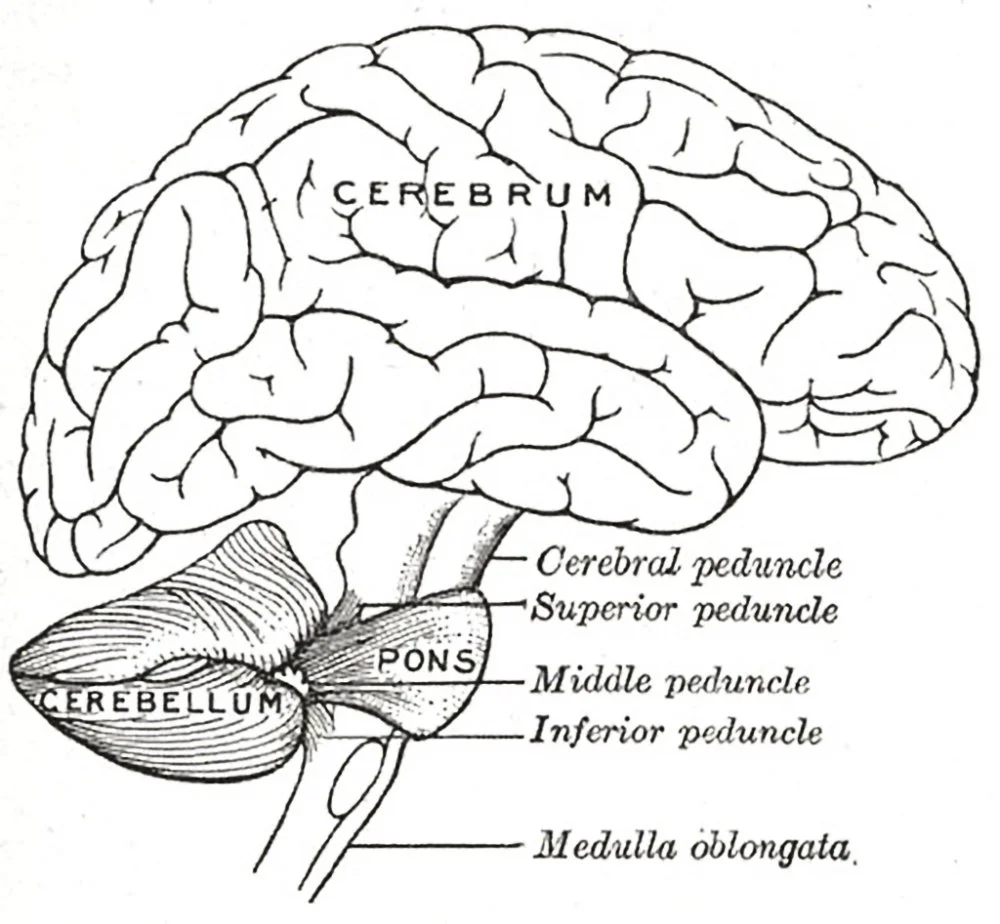
Henry Vandyke Carter Drawing of the human brain before 1858 from the book of Henry Gray Anatomy of the Human Body/Wikimedia Commons
As for the cerebellum, its functions in humans, as we now know, are not limited to coordinating movements, balance, and muscle tone (although these are likely its primary functions). The cerebellum has become something like a multifunctional onboard computer for us, specializing in correcting various errors (when what was intended does not match what actually happened). The cerebellum is also involved in working memory, emotions, speech, and social behavior. In the first three months after birth, the cerebellum in human infants grows faster than all other parts of the brain and doubles in volume within ninety days. Perhaps this holds some significance after all.
Overall, new genetic and archeological evidence demonstrates that the advantages enabling late Homo sapiens to surpass all other humans and become the dominant species on the planet were both cultural and fundamentally biological. By the onset of the late Paleolithic era, our ancestors had acquired such a distinctive amalgamation of cultural and genetic innovations that other human populations simply had no chance.
How We Became Truly Contemporary
One of the most significant milestones in Paleolithic archeology is the transition from the early Acheulean culture, which evolved over one and a half million years and was associated with Homo erectus and Homo heidelbergensis, to the more advanced and dynamic Middle Paleolithic cultures of late Homo: Neanderthals, Homo sapiens, and Denisovans.
The Acheulean period gives way to the Middle Paleolithic age, dating 200,000 to 40,000 years ago. In Europe, this is represented by the Mousterian culture of the Neanderthals, while in Africa, it's the African Middle Stone Age, a culture of similar sophistication but created by early Homo sapiens. As for the Asian Middle Paleolithic, it's likely that Denisovans lent their muscular hand to its development (although Neanderthals could have also been involved).

Mask of la Roche-Cotard Mask” of La Roche-Cotard, Stone and fossil bone, Site of “La Roche-Cotard” (Langeais) France, Around 75,600 BP, Private collection, Excavation: Jean-Claude Marquet/ Thilo Parg/Wikimedia Commons
Understanding how technological advancements align with the emergence of new symbolic behaviors is crucial. By the Upper Paleolithic era, humans had fully developed a complex of symbolic behavior: painting, figurative art (depicting real objects rather than geometric patterns or other abstractions), adornments, and ritual burials. However, the question remains: where and when did the formation of this behavior occur? This query transcends historical curiosity—its answer is philosophical.
Conventionally, it's believed that the new, genuinely human, or ‘modern’ behavior, emerged in the Upper Paleolithic era, around 60,000 to 50,000 years ago, as humans migrated out of Africa and began populating Eurasia. Yet, it's plausible that some aspects of the ‘modern’ way of life were already present among Homo sapiens in Africa during the Middle Paleolithic.
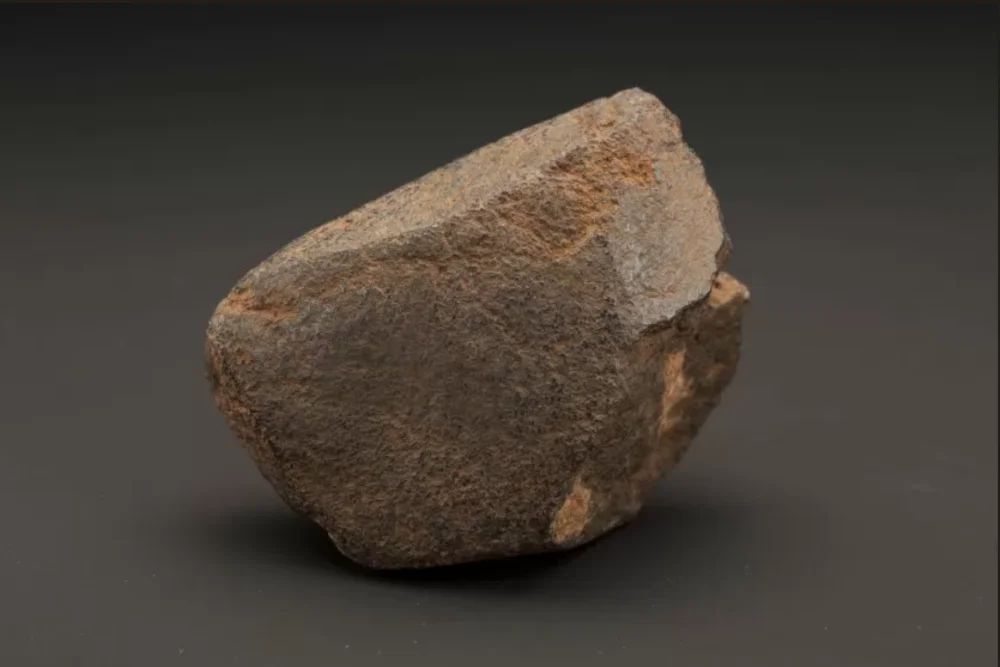
he flattened areas on this hematite pigment are signs of grinding or rubbing, telling us that it was held and used like a chunky crayon/Discovered by: Larry Barham
There is evidence of complex technological and cultural traditions among people at the Twin Rivers site in Zambia, dating back somewhere between 300,000 and 200,000 years. They were already adept at chipping and shaping stone hammers and spearheads intended to be attached to a wooden handle. At the site, remnants of natural pigments of different colors have been found, some locally sourced, while others were brought from distant locations. Red pigment (hematite) could have had purely practical purposes, such as tanning hides, fastening tool parts, or even repelling insects, but it could have also served symbolic purposes. It's worth mentioning Pinnacle Point on the coast of South Africa, which dates back to around 160,000 years ago. There, about sixty pieces of red pigment were found. Some were located near objects that may have been parts of composite tools. As with Twin Rivers, the purpose of the pigment—whether practical or symbolic—is unknown. Additionally, at Pinnacle Point, evidence of the use of marine mollusks has also been discovered.
The evidence suggesting the existence of complex culture and behavior at the onset of the Middle Stone Age (about 200,000 years ago) is extremely limited and fragmented. This underscores the significance of new findings from American archeologists at the Smithsonian Institution, who conducted detailed research on the Middle Stone Age layers in the Olorgesailie region of southern Kenya in 2018.
Olorgesailie has been under excavation for seventy-five years, but only recently have scientists focused on relatively young layers dating back to the very beginning of the Middle Stone Age, approximately between 320,000 and 295,000 years ago. Numerous stone tools that unmistakably belong to the Middle Stone Age have also been discovered within these layers.
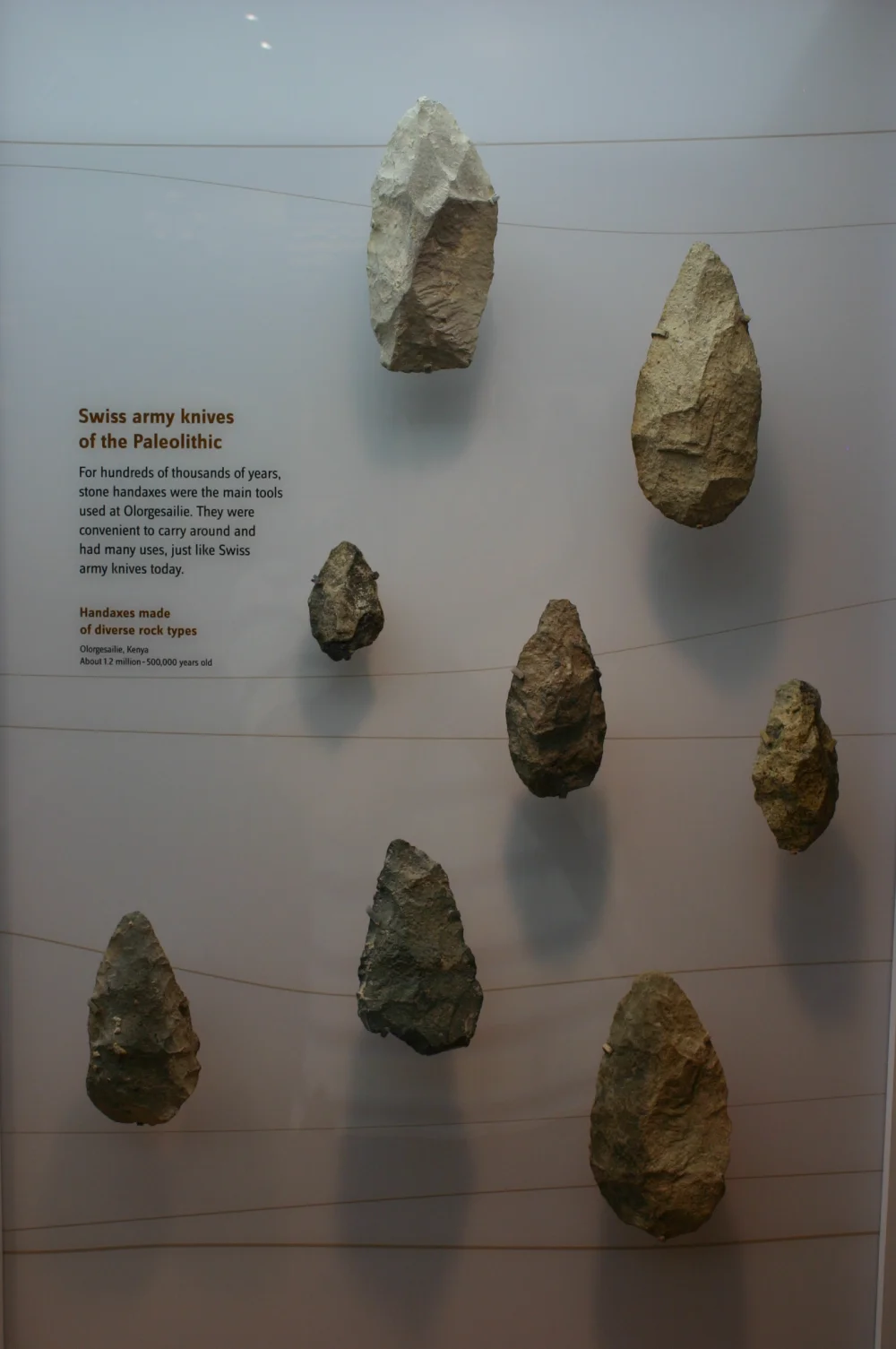
Hand axes from Olorgesailie/Wikimedia commons
Some of them were crafted from basalt, outcrops of which were easily accessible to artisans within a distance of 2–3 kilometers. However, they didn't just grab the first available pieces of basalt they saw. They preferred fine-grained basalt, which is easier to fashion into neat tools of a small size. Additionally, archeologists have unearthed numerous obsidian tools sourced from several locations within a radius of 25–50 kilometers. Judging by the abundance of small splinters and the presence of related flakes and cores, obsidian was brought in its raw form and the tools were fashioned from it onsite.
Groups of modern African hunter-gatherers, such as those in the Kalahari Desert, typically roam within a radius of no more than 20 kilometers. However, inter-tribal exchange enables valuable items to travel distances of up to 100 kilometers. It's possible that the ancient inhabitants of Olorgesailie also engaged in such exchanges, suggesting a complex social structure and advanced social skills.
Additionally, scientists have found clear evidence of pigment production in Olorgesailie. Along with stone tools, fragments of black and red minerals, which are not found elsewhere in the area, were also discovered. They were evidently brought from distant locations and scraped, presumably to create pigments. Remarkably, older Acheulean sites in the same area lack evidence of pigments or the signs of regularly transporting stones over long distances. Tools were typically made from whatever materials were readily available.
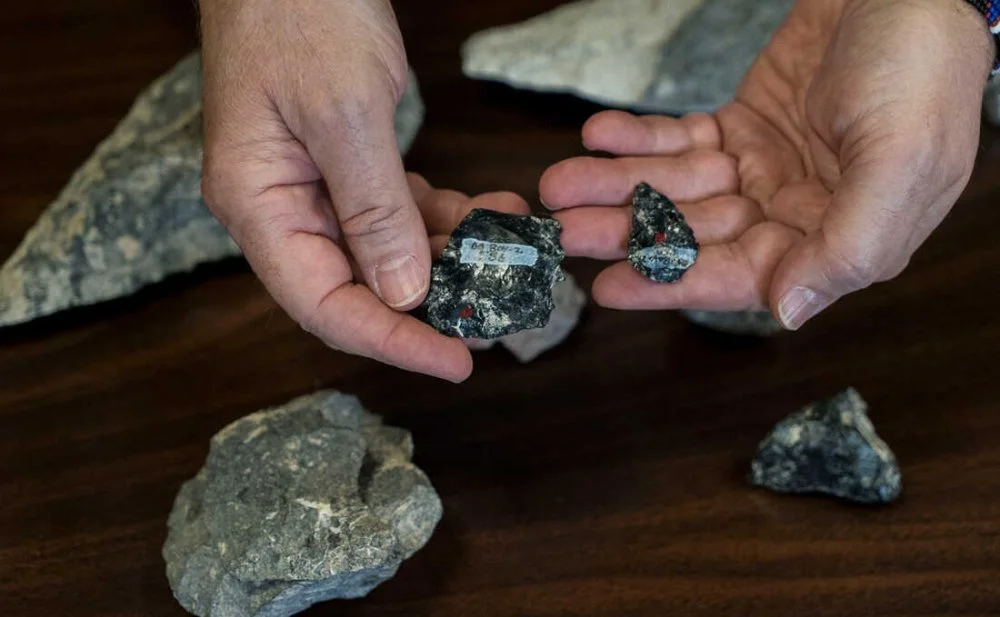
Obsidian rock found at Olorgesailie/Jay Reed/NPR
So, it's likely that in this Kenyan site, three advanced behavioral traits of modern humans emerged: wearing colorful clothing (especially red), striving for improvement, and engaging in long-distance trade. All of these appeared after 500,000 but before 300,000 years ago.
Unfortunately, no human bones have been found in the layers of the Middle Stone Age in Olorgesailie yet. Therefore, the conclusion that traces of advanced material culture were left by early Homo sapiens, similar to individuals from Jebel Irhoud or Omo, is simply based on the principle of ‘Who else could it have been?’
Thus, at the very beginning of the Middle Stone Age, 300,000 years ago, some Africans were already exhibiting ‘modern’ traits in their behavior. This means that cultural progress among our African ancestors began immediately after their brain size reached modern levels. However, as we recall, the brain shape became modern much later. This could be formulated as follows: when the brain size reached modern levels, the Middle Stone Age began, and when the brain shape also became modern, the Upper Paleolithic era began. Such a scheme, linking two critical milestones in brain evolution with key stages of cultural development, appears logical and appealing in its simplicity. However, further research will inevitably show that the reality is more complex, which is the inevitable fate of all beautiful theories. This doesn't make them any less important for the advancement of science. For now, everything is contributing to an interesting picture.

Prehistoric humans. 1920/Wikimedia commons
X-Men
Alongside early Homo sapiens, who differed little from us today, there were tribes of completely different, strange people wandering around Africa with archaic features like Homo naledi.3


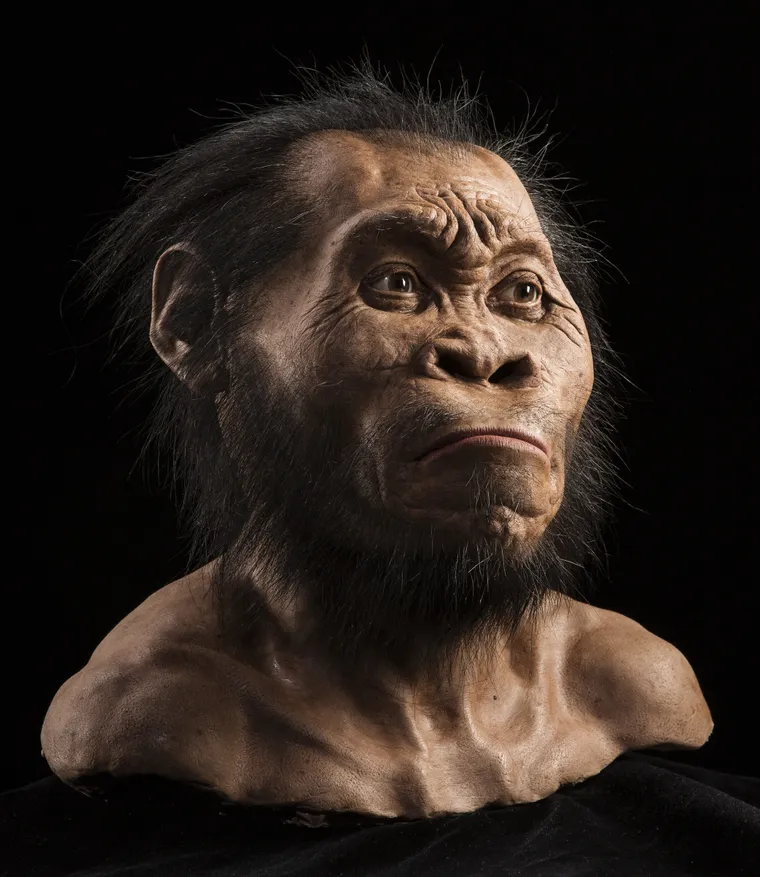
Reconstruction of the appearance of Homo Naledi/Mark Thiessen, National Geographic
The Rhodesian man's skull is one of the most famous paleoanthropological finds in history, distinguished by its exceptionally good preservation. Initially, the skull was attributed to a new species, Homo rhodesiensis, but it is now usually classified as belonging to Homo heidelbergensis.
The place of Rhodesian man on the evolutionary tree of the Homo genus has long been debated, primarily due to difficulties with dating. In 2020, it was dated to range from 274,000 to 324,000 years ago, morphologically also resembling the distant ancestors we shared with the Neanderthals.
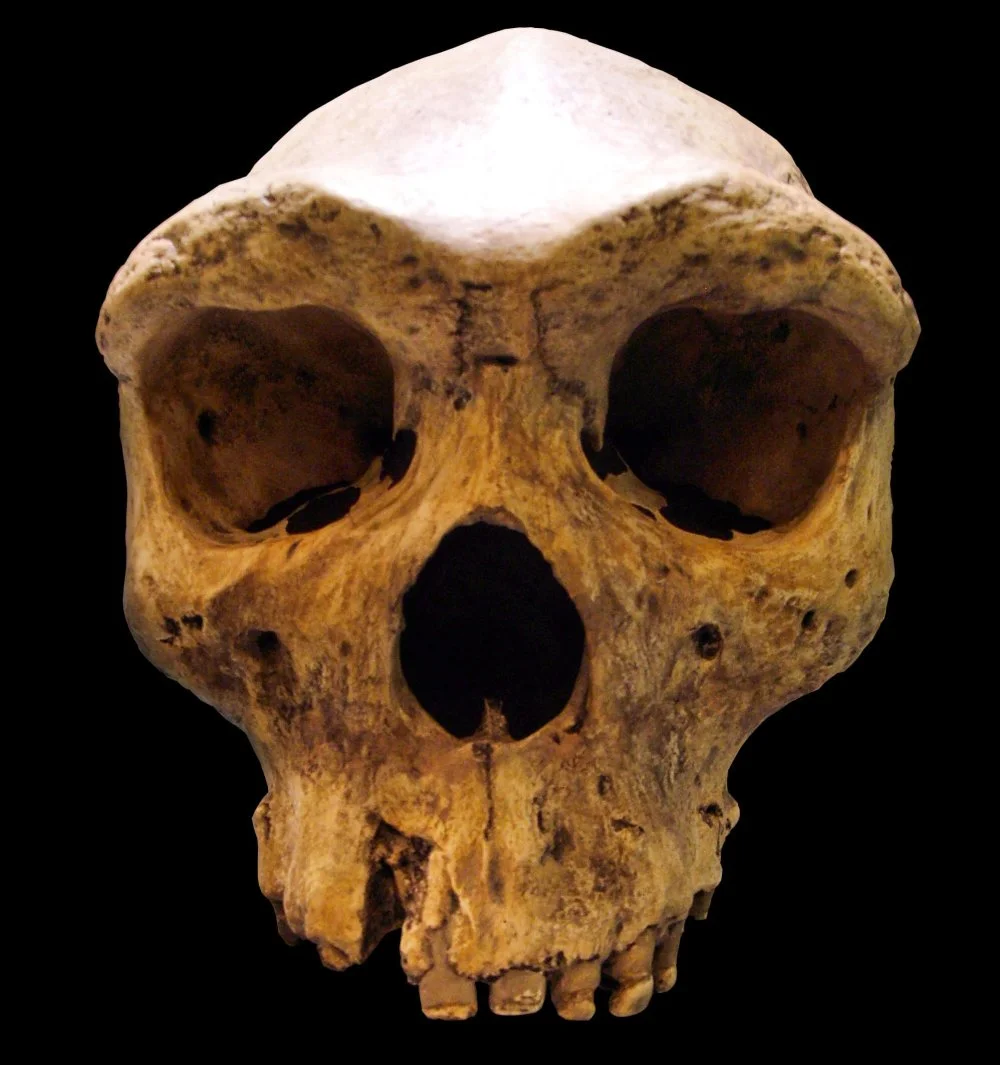
Skull of a Rhodesian man (replica)/Wikimedia commons
It appears that the species diversity among humans in Africa was comparable to that in Eurasia, where at the time Neanderthals, Denisovans, and late Homo erectus lived (according to recent data, Homo erectus inhabited Java as far back as 117,000 to 108,000 years ago). Suppose we add to this list the island ‘hobbits’ from Flores and Luzon.5
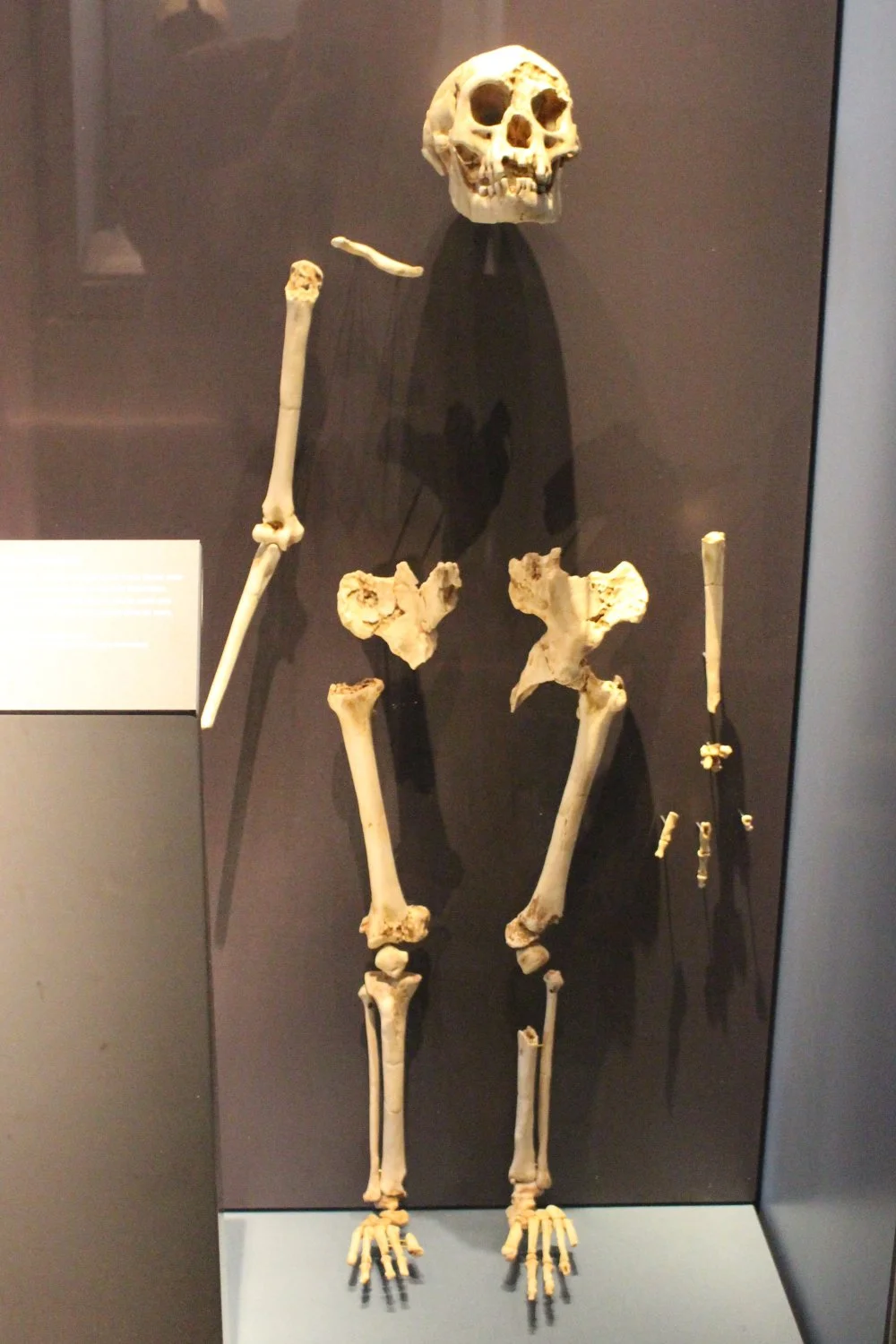
The skeleton of a Homo floresiensis woman at the Natural History Museum in London, England/Emőke Dénes/Wikimedia Commons
Here, it's fitting to recall the enigmatic genetic blends (mentioned in the first lectures of this series) found within the genomes of certain African ethnicities. Judging from genetic evidence, ancient African populations, the source of these blends, diverged from Homo sapiens long ago—perhaps even before the separation of the Homo sapiens, Neanderthal, and Denisovan lines. The archaic appearance of the Rhodesian man aligns with the hypothesis that their ancestors also split from ours quite early. With the new dating, ‘Rhodesian people’ could have encountered early Homo sapiens and thus left their genetic imprint on the genomes of present-day Africans. It's crucial to recognize that Homo sapiens, Neanderthals, and Denisovans were not the only inhabitants of this planet. We became the lone species after we prevailed over all the other diverse human species.
